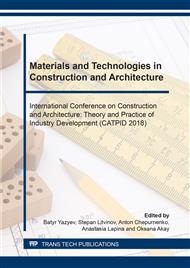p.469
p.475
p.481
p.489
p.496
p.502
p.508
p.515
p.520
Unventilated Air Layers with a Reflective Coating in the Building Envelope
Abstract:
Heat exchange through infrared radiation in air layers located inside building envelopes may be significantly modified in case of use of aluminium foil coatings therein. The intensity of conductive, convective and radiative heat exchange in these structures depends on the thickness of the air layer and the temperature difference on its surfaces. Generally speaking, application of aluminium foil in air layers of a building envelope improves its thermal insulation capacity. However, assessment of efficiency of such a solution and determination of the thermal resistance value of a given structure is often incorrectly determined and assumed for design calculations. The article analyzes the instructions and principles of determination of thermal insulation capacity of unventilated air layers. Provisions of two standards have been compared with results of tests of air layer parameters. The effect of different factors on heat exchange and insulation capacity of air layers with reflective coatings has been considered and assessed.
Info:
Periodical:
Pages:
496-501
Citation:
Online since:
September 2018
Authors:
Price:
Сopyright:
© 2018 Trans Tech Publications Ltd. All Rights Reserved
Share:
Citation:


